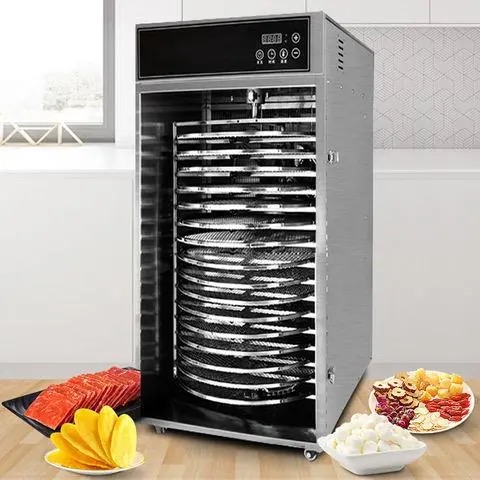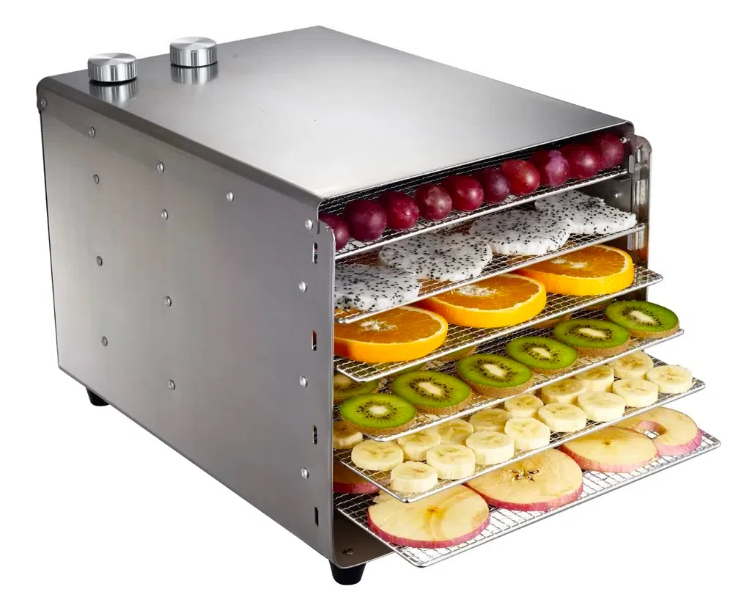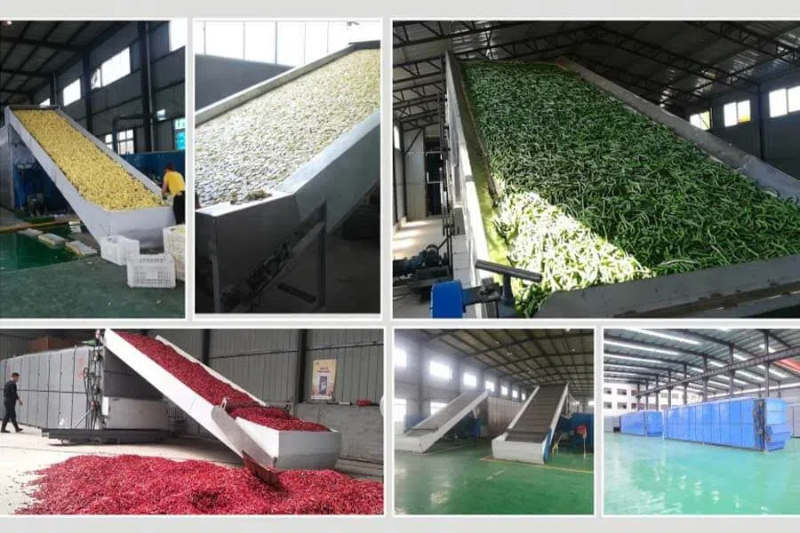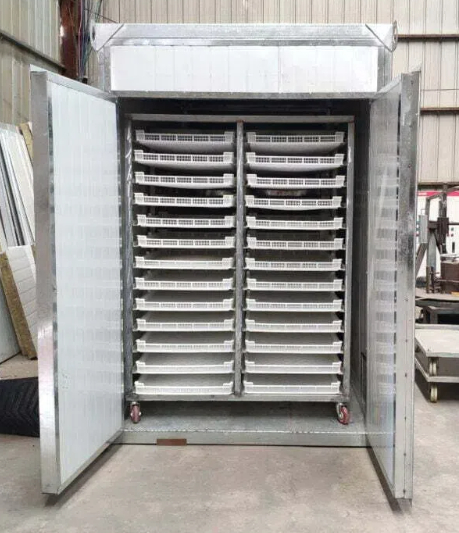
Content Menu
● Introduction to Food Drying Machines
● Types of Food Drying Machines
>> 1. Stackable Tray Dehydrators
>> 2. Box and Shelf Dehydrators
>> 3. Solar Dehydrators
>> 4. Freeze Dryers
● Commercial Food Dehydrators vs. Home Units
● Energy-Efficient Food Dryers
● Multi-Layer Dehydration Systems
● Advancements in Food Preservation Techniques
>> 1. Hybrid Drying Systems
>> 2. Pulsed Electric Field (PEF) Technology
>> 3. Ultrasound-Assisted Drying
>> 4. Microwave-Vacuum Drying
● Choosing the Right Food Drying Machine
● Conclusion
● Frequently Asked Questions
>> 1. What are the benefits of using a food drying machine?
>> 2. How do I clean and maintain my food dehydrator?
>> 3. Can I dry different types of food together in the same batch?
>> 4. How long does the food drying process typically take?
>> 5. Is it safe to store dried foods at room temperature?
Introduction to Food Drying Machines
Food drying machines, also known as dehydrators, have revolutionized the way we preserve food. These ingenious devices remove moisture from various food items, extending their shelf life while maintaining nutritional value and flavor. From home kitchens to industrial settings, food drying machines have become an essential tool for those looking to preserve fruits, vegetables, meats, and herbs.
Types of Food Drying Machines
There are several types of food drying machines available in the market, each designed to cater to different needs and capacities. Let's explore some of the most common types:
1. Stackable Tray Dehydrators
These are popular among home users due to their compact design and ease of use. Stackable tray dehydrators consist of multiple trays that can be added or removed as needed. They typically have a heating element at the base and a fan that circulates warm air through the trays.
2. Box and Shelf Dehydrators
Box and shelf dehydrators are larger units that resemble small ovens. They offer more space and are often used in commercial settings or by serious home food preservers. These machines provide consistent drying results and are ideal for processing large quantities of food.
3. Solar Dehydrators
For those interested in eco-friendly options, solar dehydrators harness the power of the sun to dry food. While they are cost-effective and energy-efficient, their performance depends on weather conditions and may not be suitable for all climates.
4. Freeze Dryers
Freeze-drying technology is a more advanced method of food preservation. These machines freeze the food and then create a vacuum environment to remove moisture. While more expensive, freeze dryers produce high-quality results and are often used for preserving delicate foods and pharmaceuticals.

Commercial Food Dehydrators vs. Home Units
The choice between commercial food dehydrators and home units depends on the scale of operation and intended use. Commercial dehydrators are designed for high-volume processing and often feature:
- Larger capacity
- More powerful heating elements and fans
- Precise temperature and humidity controls
- Durable construction for continuous operation
Home food dehydration units, on the other hand, are more compact and suitable for personal use. They offer:
- Affordability
- Easy storage and maintenance
- Sufficient capacity for family needs
- User-friendly controls
Energy-Efficient Food Dryers
As energy conservation becomes increasingly important, manufacturers are developing more energy-efficient food dryers. These models incorporate features such as:
- Improved insulation to retain heat
- LED lighting for energy savings
- Smart sensors that adjust drying time and temperature
- Programmable timers to prevent over-drying
By using energy-efficient food dryers, both commercial operators and home users can reduce their environmental impact and save on electricity costs.
Multi-Layer Dehydration Systems
Multi-layer dehydration systems are designed to maximize drying capacity while maintaining a relatively small footprint. These systems typically feature:
- Multiple removable trays or shelves
- Adjustable spacing between layers
- Even air circulation for consistent drying
- The ability to dry different foods simultaneously
Advancements in Food Preservation Techniques
The field of food preservation is constantly evolving, with new technologies emerging to improve the drying process. Some recent advancements include:
1. Hybrid Drying Systems
These systems combine different drying methods, such as convection and infrared heating, to achieve faster and more efficient drying results.
2. Pulsed Electric Field (PEF) Technology
PEF technology uses short bursts of electricity to create pores in cell membranes, allowing for faster moisture removal and potentially better retention of nutrients.
3. Ultrasound-Assisted Drying
This technique uses high-frequency sound waves to enhance moisture transfer, reducing drying time and energy consumption.
4. Microwave-Vacuum Drying
By combining microwave heating with vacuum pressure, this method can dry food quickly while preserving color, flavor, and nutritional content.

Choosing the Right Food Drying Machine
When selecting a food drying machine, consider the following factors:
1. Intended use (home or commercial)
2. Types of food to be dried
3. Desired capacity
4. Available space
5. Energy efficiency
6. Budget
7. Additional features (temperature control, timer, etc.)
By carefully evaluating these aspects, you can choose a food drying machine that best suits your needs and helps you achieve optimal results in food preservation.
Conclusion
Food drying machines have come a long way from traditional sun-drying methods. Today's dehydrators offer efficient, convenient, and versatile solutions for preserving a wide variety of foods. Whether you're a home enthusiast looking to extend the life of your garden produce or a commercial operator seeking to meet high-volume demands, there's a food drying machine designed to meet your needs. As technology continues to advance, we can expect even more innovative and efficient food preservation techniques in the future.

Frequently Asked Questions
1. What are the benefits of using a food drying machine?
Answer: Food drying machines offer several benefits, including extended food shelf life, preservation of nutrients, space-saving food storage, and the ability to create healthy snacks. They also allow for preserving seasonal fruits and vegetables for year-round enjoyment.
2. How do I clean and maintain my food dehydrator?
Answer: To clean a food dehydrator, first unplug the unit and allow it to cool. Remove the trays and wash them with warm, soapy water. Wipe down the interior with a damp cloth. For stubborn residue, use a soft brush or sponge. Ensure all parts are completely dry before reassembling. Regular cleaning after each use will help maintain your dehydrator's performance and longevity.
3. Can I dry different types of food together in the same batch?
Answer: While it's possible to dry different foods together, it's generally recommended to dry similar items in the same batch. Foods with similar drying times and moisture content work best together. Avoid mixing strongly flavored foods with milder ones, as flavors can transfer during the drying process.
4. How long does the food drying process typically take?
Answer: The drying time can vary significantly depending on the type of food, its moisture content, the dehydrator's efficiency, and the desired level of dryness. Herbs may take only 2-4 hours, while fruits can take 6-12 hours, and meats may require 8-16 hours or more. Always refer to your dehydrator's manual and specific recipes for accurate drying times.
5. Is it safe to store dried foods at room temperature?
Answer: Properly dried and stored foods can be safely kept at room temperature. However, it's crucial to ensure that the food is thoroughly dried and stored in airtight containers away from light, heat, and moisture. For best results, store dried foods in a cool, dark place. Some dried foods, especially those with higher fat content, may benefit from refrigeration or freezing for extended storage.












